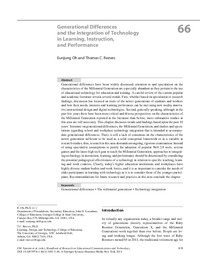Generational Differences and the Integration of Technology in Learning, Instruction, and PerformanceEunjung Oh, Thomas C. Reeves
Zu finden in: Handbook of Research on Educational Communications and Technology (Seite 819 bis 828), 2014
|
 |
 Diese Seite wurde seit 8 Jahren inhaltlich nicht mehr aktualisiert. Unter Umständen ist sie nicht mehr aktuell.
Diese Seite wurde seit 8 Jahren inhaltlich nicht mehr aktualisiert. Unter Umständen ist sie nicht mehr aktuell. Zusammenfassungen
Zusammenfassungen
 Generational differences have been widely discussed; attention to and speculation on the characteristics of the Millennial Generation are especially abundant as they pertain to the use of educational technology for education and training. A careful review of the current popular and academic literature reveals several trends. First, whether based on speculation or research findings, discussion has focused on traits of the newer generations of students and workers and how their needs, interests and learning preferences can be met using new media, innovative instructional design and digital technologies. Second, generally speaking, although in the past few years there have been more critical and diverse perspectives on the characteristics of the Millennial Generation reported in the literature than before, more substantive studies in this area are still necessary. This chapter discusses trends and findings based upon the past 10 years´ literature on generational differences, the Millennial Generation, and studies and speculations regarding school and workplace technology integration that is intended to accommodate generational differences. There is still a lack of consensus on the characteristics of the newer generation sufficient to be used as a solid conceptual framework or as a variable in research studies; thus, research in this area demands an ongoing, rigorous examination. Instead of using speculative assumptions to justify the adoption of popular Web 2.0 tools, serious games and the latest high tech gear to teach the Millennial Generation, approaches to integrating technology in instruction, learning, and performance should be determined by considering the potential pedagogical effectiveness of a technology in relation to specific teaching, learning and work contexts. Clearly, today´s higher education institutions and workplaces have highly diverse student bodies and work forces, and it is as important to consider the needs of older participants in learning with technology as it is to consider those of the younger participants. Recommendations for future research and practices in this area conclude the chapter.
Generational differences have been widely discussed; attention to and speculation on the characteristics of the Millennial Generation are especially abundant as they pertain to the use of educational technology for education and training. A careful review of the current popular and academic literature reveals several trends. First, whether based on speculation or research findings, discussion has focused on traits of the newer generations of students and workers and how their needs, interests and learning preferences can be met using new media, innovative instructional design and digital technologies. Second, generally speaking, although in the past few years there have been more critical and diverse perspectives on the characteristics of the Millennial Generation reported in the literature than before, more substantive studies in this area are still necessary. This chapter discusses trends and findings based upon the past 10 years´ literature on generational differences, the Millennial Generation, and studies and speculations regarding school and workplace technology integration that is intended to accommodate generational differences. There is still a lack of consensus on the characteristics of the newer generation sufficient to be used as a solid conceptual framework or as a variable in research studies; thus, research in this area demands an ongoing, rigorous examination. Instead of using speculative assumptions to justify the adoption of popular Web 2.0 tools, serious games and the latest high tech gear to teach the Millennial Generation, approaches to integrating technology in instruction, learning, and performance should be determined by considering the potential pedagogical effectiveness of a technology in relation to specific teaching, learning and work contexts. Clearly, today´s higher education institutions and workplaces have highly diverse student bodies and work forces, and it is as important to consider the needs of older participants in learning with technology as it is to consider those of the younger participants. Recommendations for future research and practices in this area conclude the chapter. Dieses Kapitel erwähnt ...
Dieses Kapitel erwähnt ...
 Anderswo finden
Anderswo finden
 Volltext dieses Dokuments
Volltext dieses Dokuments
 |  Generational Differences and the Integration of Technology in Learning, Instruction, and Performance: Artikel als Volltext bei Springerlink ( Generational Differences and the Integration of Technology in Learning, Instruction, and Performance: Artikel als Volltext bei Springerlink ( : :  , 253 kByte; , 253 kByte;  : :  2020-11-28) 2020-11-28) |
 Anderswo suchen
Anderswo suchen 
 Beat und dieses Kapitel
Beat und dieses Kapitel
Beat hat Dieses Kapitel während seiner Zeit am Institut für Medien und Schule (IMS) ins Biblionetz aufgenommen. Er hat Dieses Kapitel einmalig erfasst und bisher nicht mehr bearbeitet. Beat besitzt kein physisches, aber ein digitales Exemplar. Eine digitale Version ist auf dem Internet verfügbar (s.o.). Aufgrund der wenigen Einträge im Biblionetz scheint er es nicht wirklich gelesen zu haben. Es gibt bisher auch nur wenige Objekte im Biblionetz, die dieses Werk zitieren.











 Biblionetz-History
Biblionetz-History